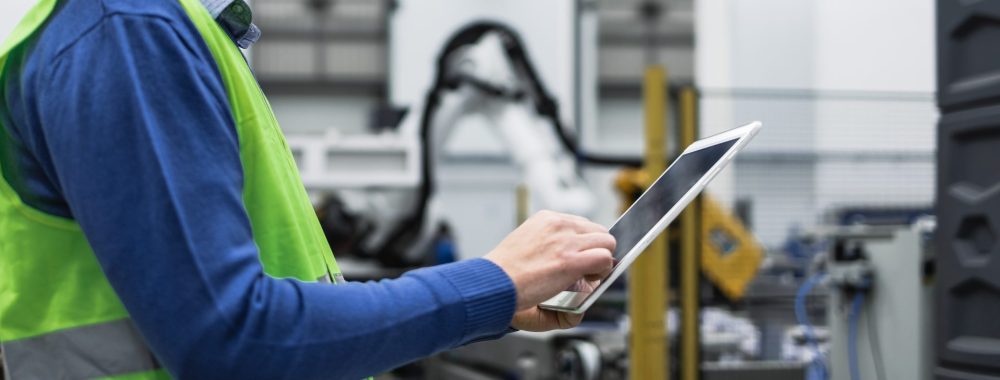The industrial revolution brought about a major socio-economic change in society. It took place in the United Kingdom, and gradually spread to developed countries.
Like any period of change, it had different stages, although today we are going to focus on the birth of the Internet and R&D. Two key aspects that triggered the third Industrial Revolution and whose evolution has led us to today’s Industry 4.0.
In this new stage, competitiveness and, consequently, business demands are increasing. It is therefore necessary to incorporate new technologies into production processes, which facilitate an exponential increase in performance thanks to their ability to connect the physical and digital worlds.
Production control
The control system arises from the need to supervise all the operations carried out in a production process: machinery operation, quality of products and/or services, optimization of the materials used, among others.
In short, it could be defined as: the method that integrates all production data and provides them with value to check that the activities of a business are developing as planned. All this with the aim of implementing improvements that have a direct impact on increasing the percentage of performance, also known as OEE, Overall Equipment Effectiveness.
Essential aspects for controlling a company’s production.
Quality management is not only focused on the quality of the product or service and customer satisfaction, but also on the means and processes that are developed to obtain it. Therefore, to achieve an adequate control of outputs it is necessary to supervise all activities and monitor the permanent operation of machinery and the optimization of materials and employees.
Through the use of control platforms it is possible to guarantee: the flow of all processes, cost savings and improvement of final results, control in the management of resources and supplies and compliance with established deadlines.
INDUSTRIAL AUTOMATION 4.0
The ideal tool to control your production
The main purpose of internal control systems is to optimize costs without losing the quality of the products and/or services developed.
How do they achieve this? New Iot technologies, combined with Artificial Intelligence (AI) and Big Data, give way to new centralized management software platforms, which allow advanced control actions, with greater level of detail on each part of the manufacturing processes and equipment maintenance.
The collection of information through sensors, travels to centralized systems that process thousands of data, and then, display the information in an easy and simple way, with which quality managers, operations and managers can make better decisions based on data.
The new control systems offer several advantages, which vary depending on the industry and the company’s degree of flexibility. However, there are some common advantages:
- Access to all information. The control software interconnects all devices, both in production and/or storage plants, as well as in sales and human resources departments, in order to collect, process and serve relevant information to the members of the organization’s management. This can be consulted at any time and place if cloud technologies are used, where there are no physical barriers and only a user and access via internet connection are needed.
- Production forecasting. With the global overview provided by these tools, it is much easier to make real approximations of production. Similarly, thanks to the monitoring system, it is possible to check the management of scope, time and cost. In other words, the optimal production performance can be established, as well as the estimation of resources in terms of quality, quantity and timeliness.
- Decision making. The analysis offered by a control software is more complete than any of the traditional control methods. This makes it easier to manage and improve decision making.
- Strategy. With an updated and organized access to information a company is able to; develop better responses to crises and / or unforeseen events and, in turn, minimize the potential risk.
- Reduce costs. As a result of all the above, with a control software based on new digital technologies it is possible to reduce costs arising from manufacturing processes, lack of organization and performance, among others.
Nexus Integra, the tool that allows you to control and operate your company’s production in a centralized way.
Nexus Integra is the integrated operations platform that allows you to connect and operate all your assets, adapting to systems previously implemented in the company. You will be able to visualize, analyze and control processes, obtaining a 360º vision of the company.
Its Big Data and Machine learning technology uses specific algorithms that analyze production performance to transform data into valuable information, and thus offer managers and executives greater capacity and maneuverability in management and decision making.
Nexus Integra is a competitive advantage in the market, as it offers 100% flexibility and autonomy.
Results of the application of Nexus Integra in industrial companies
Do you want to know its impact on performance? We tell you about it below with real cases.
Realonda
Realonda is a company dedicated to the manufacture of ceramic tiles, with more than 80 years of experience.
The customized solution provided by Nexus Integra makes it possible today, not only to obtain process data in real time, but also to integrate and correlate information from different sources, which allows a much more complete and detailed analysis of the needs at each stage of the production process and to make decisions in a faster and more reliable way.
Results:
- Greater control based on real-time data
- Improved response times
- Improved organization and production planning
- Reduced production losses
- Savings in maintenance costs
Giahsa
Gestión Integral del Agua de Huelva (GIAHSA) has implemented Nexus Integra, for the monitoring and control of its facilities and processes of the integral water cycle.
The applied solution allows to supervise industrial processes remotely from the Smart SCADA application, in addition to offering applications for statistical data processing, parameterize alarms on such data and interoperate with other applications.
Results:
- 20% reduction in maintenance costs
- Centralized process monitoring system
- Remote operation system (maneuver management and sending of set points).
- Automation of operation reports
You are just one step away from improving your production efficiency and performance.
Our specialized team will audit your processes.


